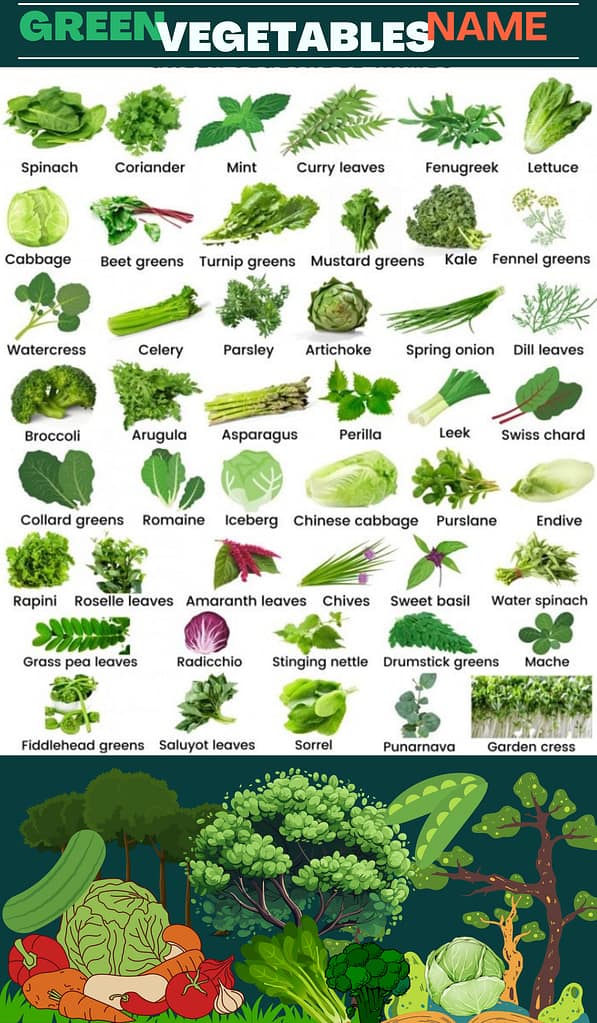Green vegetables offer significant health benefits. They are packed with essential nutrients, including protein, vitamins, and other vital elements crucial for our well-being. To help you recognize these important green vegetables name, we’ve provided a list below that can be very helpful for anyone looking to learn about them.
- Explore Over 200 Vegetables name in English with pictures: From A-Z list
- Comprehensive List of Over 100 farm Animals name in English with Images : A-Z list
- Comprehensive List of Over 100 Domestic Animals name in English with Images : A-Z list
- Comprehensive List of Over 200 Pet Animals name in English with Images : A-Z list

About green vegetables
Green vegetables refer to a diverse group of nutrient-rich plants characterized by their vibrant green hue, stemming from chlorophyll pigments. Packed with essential vitamins, minerals, and antioxidants, they promote overall health and well-being, making them a crucial component of a balanced diet.
Green vegetables name: A-Z list
- Asparagus
- Artichoke
- Arugula
- Avocado (technically a fruit, but often used as a vegetable)
- Amaranth Greens
- Anaheim Pepper
- Arracacha
- Ahipa
- Azuki Bean Sprouts
- Armenian Cucumber
- Aonori
- Agave Shoots
- Ash Gourd
- Amanatsu
- Ampalaya (Bitter Melon)
- Arrowhead
- Avocado Leaves
- Agretti
- Anise Hyssop
- Arracacha
- Broccoli
- Brussels sprouts
- Bok choy
- Butterhead lettuce
- Beet greens
- Bell peppers (green)
- Broad beans
- Bamboo shoots
- Baby bok choy
- Butterbeans
- Black-eyed peas
- Bitter melon
- Buttercrunch lettuce
- Buttercup squash (when immature)
- Bibb lettuce
- Bull’s blood beet greens
- Batavian endive
- Banana pepper (when unripe)
- Baby cos lettuce
- Brown mustard greens
- Collard Greens
- Cabbage
- Celery
- Chard
- Chicory
- Chinese Broccoli
- Chinese Cabbage
- Choy Sum
- Corn Salad
- Cucumber
- Dandelion Greens
- Edamame
- Endive
- Fennel
- Fenugreek
- Frisée
- Fiddlehead Ferns
- Green Beans
- Green Bell Pepper
- Green Cabbage
- Green Chard
- Green Kale
- Green Leaf Lettuce
- Green Lentils
- Green Okra
- Green Olives
- Green Onions
- Green Peas
- Green Pepper
- Green Spinach
- Green Squash
- Green Tomatillo
- Green Tomato
- Green Zucchini
- Green Asparagus
- Green Artichoke
- Green Avocado
- Green Brussels Sprouts
- Green Bok Choy
- Green Broccoli
- Green Cauliflower
- Green Celery
- Green Cucumber
- Green Endive
- Green Garlic
- Green Ginger
- Green Jicama
- Green Kohlrabi
- Green Leeks
- Green Lima Beans
- Green Mushrooms
- Green Mustard Greens
- Green Napa Cabbage
- Green Papaya
- Green Peppers
- Green Radishes
- Green Serrano Peppers
- Hubbard Squash
- Iceberg Lettuce
- Jalapeno Pepper
- Jerusalem Artichoke
- Kale
- Kohlrabi
- Leek
- Lima Bean
- Long Bean
- Looseleaf Lettuce
- Luffa Gourd
- Mizuna
- Mustard Greens
- Napa Cabbage
- Okra
- Oregano
- Parsley
- Parsnip
- Pea Shoots
- Peas
- Quinoa
- Radicchio
- Rapini
- Romaine Lettuce
- Rutabaga
- Salsify
- Scallion
- Sorrel
- Spinach
- Sugar Snap Peas
- Swiss Chard
- Tatsoi
- Tomatillo
- Turnip Greens
- Upland cress
- Vigna
- Wasabi
- Watercress
- Wax gourd
- Wild leek
- Yam
- Yardlong bean
- Zucchini
Benefits of Green vegetables
Green vegetables offer a wide range of health benefits:
- Nutrient-Rich: They are packed with essential vitamins (such as A, C, K, and folate), minerals (like potassium, calcium, and iron), and dietary fiber.
- Antioxidants: They are rich in antioxidants, which help protect your cells from damage caused by free radicals.
- Digestive Health: The fiber in green vegetables aids in digestion and helps maintain a healthy digestive system.
- Weight Management: They are low in calories and high in fiber, making them an excellent choice for those looking to manage their weight.
- Heart Health: They can help reduce the risk of heart disease due to their high potassium content, which helps regulate blood pressure.
- Bone Health: Green leafy vegetables like kale and spinach are excellent sources of calcium, crucial for maintaining strong bones.
- Cancer Prevention: Some green vegetables, like broccoli and Brussels sprouts, contain compounds that may help protect against certain types of cancer.
- Eye Health: Vegetables like kale, spinach, and broccoli are rich in lutein and zeaxanthin, which are beneficial for eye health.
- Blood Sugar Control: The fiber in green vegetables can help regulate blood sugar levels, making them a good choice for people with diabetes.
- Improved Immune Function: The vitamins and minerals in green vegetables contribute to a strong immune system.
- Detoxification: Some green vegetables, like kale and cilantro, contain compounds that support the body’s natural detoxification processes.
- Skin Health: The antioxidants in green vegetables can help maintain healthy skin and prevent premature aging.
Remember, it’s important to include a variety of colorful fruits and vegetables in your diet to ensure you get a wide range of nutrients.
Uses of green vegetables
Green vegetables are incredibly nutritious and versatile. Here are some common uses for them:
- Salads: Green vegetables like lettuce, spinach, kale, and arugula are staples in salads, providing essential vitamins, minerals, and fiber.
- Smoothies: Leafy greens like spinach or kale can be blended into smoothies for an extra boost of nutrients without altering the taste significantly.
- Stir-Fries: Vegetables like broccoli, bell peppers, snap peas, and zucchini are excellent additions to stir-fry dishes, providing color, texture, and nutrients.
- Soups and Stews: Spinach, kale, and other greens can be added to soups and stews to enhance both flavor and nutritional content.
- Sandwiches and Wraps: Lettuce, spinach, and other greens make great additions to sandwiches and wraps, adding a fresh crunch.
- Sautéed or Steamed Sides: Many green vegetables, like asparagus, green beans, and bok choy, can be quickly sautéed or steamed as a nutritious side dish.
- Pasta and Grain Bowls: Spinach, kale, or peas can be stirred into pasta or grain bowls to increase the vegetable content.
- Frittatas and Omelettes: Spinach, broccoli, and other greens can be incorporated into egg dishes for added flavor and nutrients.
- Pesto: Basil, a green herb, is a key ingredient in pesto sauce, providing a vibrant color and unique flavor.
- Wraps and Rolls: Collard greens or lettuce leaves can be used as a substitute for tortillas or bread in wraps and rolls.
- Pizza Toppings: Spinach, arugula, and broccoli can be used as toppings on pizzas, adding a nutritious twist to this comfort food.
- Sauces and Dips: Herbs like cilantro and parsley are often used in sauces and dips, providing both flavor and a nutritional boost.
- Grilled Vegetables: Zucchini, eggplant, and bell peppers can be grilled to create a flavorful and nutritious side dish or addition to sandwiches.
- Garnishes: Fresh herbs like parsley or cilantro are commonly used as garnishes to add color and flavor to dishes.
- Snacks: Vegetables like cucumber, celery, and snap peas make excellent crunchy snacks when paired with dips or hummus.
Remember, incorporating a variety of green vegetables into your diet can provide a wide range of nutrients and health benefits. It’s recommended to eat a diverse array of colors in your fruits and vegetables to ensure you’re getting a broad spectrum of nutrients.
Amazing facts about Green vegetables
Here are some amazing facts about various green vegetables:
| Vegetable Name | Amazing Fact |
|---|---|
| Spinach | High in iron, it was famously praised by Popeye the Sailor. |
| Broccoli | Contains more vitamin C than an orange. |
| Kale | One of the most nutrient-dense foods on the planet. |
| Asparagus | Can grow up to 7 inches in a single day under ideal conditions. |
| Avocado | Technically a berry, it’s rich in healthy fats and potassium. |
| Brussels Sprouts | Originated from Belgium and named after the capital city. |
| Green Peas | High in protein and considered both a vegetable and legume. |
| Zucchini | Botanically classified as a fruit, but commonly cooked as a veg. |
| Cabbage | Comes in many varieties, including green, red, and savoy. |
| Green Beans | Are actually immature pods of bean plants. |
These are just a few fascinating facts about some popular green vegetables! There are many more out there with their own unique qualities and benefits.
Conclusion
In conclusion, familiarizing oneself with over 100 green vegetable names in English can greatly enhance one’s understanding of their nutritional value and benefits. This comprehensive list serves as an invaluable resource for those keen on incorporating these nutrient-rich options into their diet. By harnessing the power of these green vegetables, we can take significant strides towards better health and overall well-being. Explore, experiment, and enjoy the diverse array of options nature has provided for us. Happy learning!
FAQ: Frequently Asked Questions
What are the top 10 green vegetables to eat?
Here are ten popular green vegetables that are known for their nutritional benefits:
Spinach
Kale
Broccoli
Brussels Sprouts
Green Beans
Asparagus
Peas
Avocado (technically a fruit, but often treated as a vegetable)
Zucchini
Cabbage
Including a variety of these in your diet can provide a range of vitamins, minerals, and other essential nutrients. Keep in mind that a diverse diet with a mix of different colored fruits and vegetables is generally recommended for optimal nutrition.
Green vegetables name in india?
Here are some commonly consumed green vegetables in India:
Spinach (Palak)
Fenugreek Leaves (Methi)
Bottle Gourd Leaves (Lauki Ke Patte)
Amaranth Leaves (Chaulai Ke Patte)
Mustard Leaves (Sarson Ka Saag)
Coriander Leaves (Dhaniya Patta)
Mint Leaves (Pudina Patta)
Green Beans (French Beans)
Bitter Gourd (Karela)
Ridge Gourd (Turai)
Cluster Beans (Gawar Phali)
Drumstick Leaves (Moringa Leaves)
Lady’s Finger (Okra or Bhindi)
Green Peas (Hari Matar)
Cabbage (Patta Gobi)
These are just some examples, and there are many more varieties of green vegetables consumed in different regions of India.

